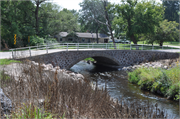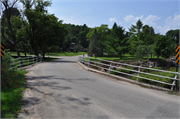| Additional Information: | 2018-
The Mill Street Bridge is located in the Village of Scandinavia, Waupaca County. It was built in 1907 by Lars Anderson. The engineer is not known.
The structure is a rubble-fieldstone (mostly granite), segmental-arch bridge with sandstone ring stones, metal pipe railings, and slightly flared wing walls at each end. In 1981, the abutments were encased in concrete to guard against scour (an inscription in the concrete bears the date “1981”). Springing about 1 foot above the waterline, the arch rises about 6 feet over a span of about 29 feet. Of the 45, stone-arch, country bridges known to have been built in Waupaca County during 1899-1912, only 9 survive. Two are of coursed-ashlar, granite construction; the remainder are of rubble fieldstone.
The only other region in Wisconsin with a sizeable sample of rubble-fieldstone, bridges is Price County. There the masonry consists of fairly large, unevenly shaped, granite boulders heavily buttered with mortar. On Waupaca County country bridges, however, the fieldstone tends to be smaller and more uniformly oval, averaging 10-16 inches in diameter with mortar joints about 1 inch thick. The result is quite decorative. The Mill Bridge is an excellent example of this important, regional, building type. Its significance is enhanced by its proximity to an excellent example of coursed-ashlar, granite, bridge construction (AHI #238727, Main St Bridge) about one-half mile upstream, also in the Village of Scandinavia. Together, these two bridges document the regional tradition of stone-arch bridge construction that flourished in Waupaca County during the first decade of the twentieth century.
In July 1907, the Scandinavia Village Board voted to “have a stone bridge built across [the] river below [the] mill” in the center of the village. A month later, a contract was let to the low bidder, Lars Anderson, a local mason-contractor. The bridge was accepted by the village board the following November for a total cost of $1,027.40. The bridge’s construction was part of a general economic boom in the village, which ten consisted of about 450 people. Civic improvements included the establishment of a bank (1900) and telephone company (1903), as well as the completion of another stone-arch bridge (1906) at the north end of the village. (Main St Bridge) Historically significant as an important, local landmark, the Mill Bridge continues in use as the village’s main thoroughfare across the Little Wolf River. stone arch bridge |
|---|


